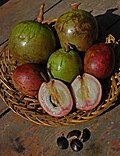Chrysophyllum cainito
Chrysophyllum cainito is a tropical tree of the family Sapotaceae. It is native to the Greater Antilles and the West Indies. It has spread to other parts of the world, and has become naturalized in parts of Southeast Asia and in tropical regions of the Americas.
Description[edit]
The Chrysophyllum cainito tree can grow up to 20 meters in height. It has glossy, dark green leaves with a golden underside. The tree produces a round, purple fruit that is commonly known as the star apple. The fruit has a sweet, milky juice and is often eaten fresh.
Cultivation[edit]
Chrysophyllum cainito is cultivated for its fruit in tropical and subtropical regions. It is a relatively hardy tree, able to tolerate a range of soil types and conditions. However, it prefers a well-drained, sandy soil and a position in full sun. The tree is propagated from seed, which can take several years to bear fruit.
Uses[edit]
The fruit of the Chrysophyllum cainito tree is eaten fresh, and is also used in jams and jellies. The wood of the tree is used in construction and furniture making. In traditional medicine, the leaves and bark of the tree are used to treat a range of ailments, including diabetes and hypertension.
See also[edit]
This tropical agriculture related article is a stub. You can help WikiMD by expanding it.
This medicinal plants related article is a stub. You can help WikiMD by expanding it.
-
Chrysophyllum cainito
-
Chrysophyllum cainito
-
Star Apple (Kaimito)
-
Chrysophyllum cainito
-
Chrysophyllum cainito
Ad. Transform your life with W8MD's Budget GLP-1 injections from $49.99


W8MD offers a medical weight loss program to lose weight in Philadelphia. Our physician-supervised medical weight loss provides:
- Weight loss injections in NYC (generic and brand names):
- Zepbound / Mounjaro, Wegovy / Ozempic, Saxenda
- Most insurances accepted or discounted self-pay rates. We will obtain insurance prior authorizations if needed.
- Generic GLP1 weight loss injections from $49.99 for the starting dose of Semaglutide and $65.00 for Tirzepatide.
- Also offer prescription weight loss medications including Phentermine, Qsymia, Diethylpropion, Contrave etc.
NYC weight loss doctor appointmentsNYC weight loss doctor appointments
Start your NYC weight loss journey today at our NYC medical weight loss and Philadelphia medical weight loss clinics.
- Call 718-946-5500 to lose weight in NYC or for medical weight loss in Philadelphia 215-676-2334.
- Tags:NYC medical weight loss, Philadelphia lose weight Zepbound NYC, Budget GLP1 weight loss injections, Wegovy Philadelphia, Wegovy NYC, Philadelphia medical weight loss, Brookly weight loss and Wegovy NYC
|
WikiMD's Wellness Encyclopedia |
| Let Food Be Thy Medicine Medicine Thy Food - Hippocrates |
Medical Disclaimer: WikiMD is not a substitute for professional medical advice. The information on WikiMD is provided as an information resource only, may be incorrect, outdated or misleading, and is not to be used or relied on for any diagnostic or treatment purposes. Please consult your health care provider before making any healthcare decisions or for guidance about a specific medical condition. WikiMD expressly disclaims responsibility, and shall have no liability, for any damages, loss, injury, or liability whatsoever suffered as a result of your reliance on the information contained in this site. By visiting this site you agree to the foregoing terms and conditions, which may from time to time be changed or supplemented by WikiMD. If you do not agree to the foregoing terms and conditions, you should not enter or use this site. See full disclaimer.
Credits:Most images are courtesy of Wikimedia commons, and templates, categories Wikipedia, licensed under CC BY SA or similar.
Translate this page: - East Asian
中文,
日本,
한국어,
South Asian
हिन्दी,
தமிழ்,
తెలుగు,
Urdu,
ಕನ್ನಡ,
Southeast Asian
Indonesian,
Vietnamese,
Thai,
မြန်မာဘာသာ,
বাংলা
European
español,
Deutsch,
français,
Greek,
português do Brasil,
polski,
română,
русский,
Nederlands,
norsk,
svenska,
suomi,
Italian
Middle Eastern & African
عربى,
Turkish,
Persian,
Hebrew,
Afrikaans,
isiZulu,
Kiswahili,
Other
Bulgarian,
Hungarian,
Czech,
Swedish,
മലയാളം,
मराठी,
ਪੰਜਾਬੀ,
ગુજરાતી,
Portuguese,
Ukrainian




